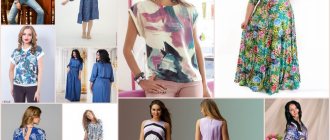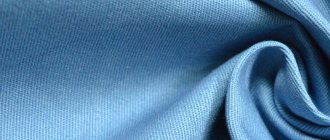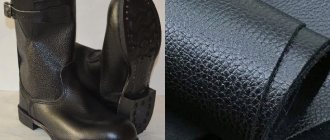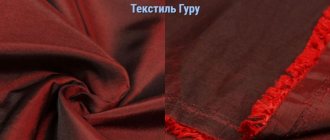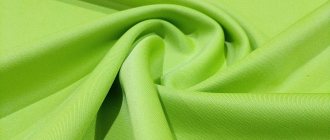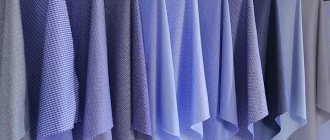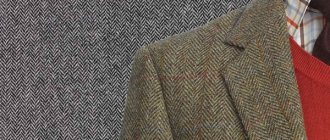Description and properties
Teak is a thick cotton or linen fabric with a plain, twill or satin weave between the weft and warp. In the production of the material, thick threads of yarn are used, so the output of the weaving machine is fabric with a density of 140-160 g/m2. At the same time, there are different canvases in width; below are their descriptions.
Advantages of the material:
- strength;
- durability;
- shape retention and low creasing;
- abrasion resistance;
- hygroscopicity;
- hypoallergenic (applies only to fabric without synthetic additives);
- breathability.
There are also disadvantages:
- difficulty sewing due to density;
- moisture absorption. When storing material at high humidity, it becomes heavily saturated with water and does not dry well;
- low contrast and brightness of patterns and colors in mattress types of fabric. This feature is caused by the use of coarse yarn from natural raw materials, which does not have a pronounced shine.
Characteristics, composition and description
The first fabric with a dense structure was made from flax and was called kutit or zatrapeza. The first comes from the French “mattress”, and the second from the name of the merchant who began producing this material. Times changed, and the name “teak” came into the world. Some say that it came from Dutch, others from English, but the origin of the word is absolutely European.
Rich and luxurious material
Note: The first products made from this fabric were underwear and corsets for noble ladies. Then shoes began to appear, which can still be seen in museums. Natural linen fabrics were a great luxury, so they were worn only for big events. Over time, teak began to be produced from cotton.
Corset
In the modern world, many variations of the material have appeared, but only natural fibers are still used. Existing weave types:
- twill - a scar is visually visible on the fabric;
- linen - the result is a smooth, pleasant material;
- satin - this type of weave is considered the first of those that appeared, but is now practically not used.
You might be interested in what kind of material Lyosel is: natural or artificial
Lingerie
The most important characteristic of teak material is its high density - 140 g/m2-160 g/m2. It depends on the density how the canvas will be used:
- low density is used for products that must be thin and delicate - curtains, drapes, bedding, clothing (usually work clothes);
- medium density is ideal for pillowcases and mattress covers;
- high density is well suited for mattress covers, test covers, furniture covers and even blinds (such as Roman blinds).
High-density fabric is also used for sewing feather or down blankets and pillows, but in this case it is impregnated with special agents that protect the inner material and prevent it from coming out.
Durable and durable fabric
Also, depending on the area of application, teak material is painted in different ways:
- plain-painted - clothing (for ordinary special applications) is painted white or black teak, the rest is painted in light colors;
- variegated - an interesting type of dyeing that is obtained when the fabric is initially woven from threads of different colors (usually the result is a pattern in the form of long stripes, squares or herringbones);
- printed (printing on linen) - this method produces fabrics with various interesting patterns that are applied to an already woven fabric; most often bed linen is dyed using this method.
By the way, the fabric lends itself to dyeing very well. 100% cotton fabrics are always painted white (this may answer the question, what color is teak?).
Dyed matter
As for the composition of teak, as mentioned above, it is predominantly a natural fabric that can be obtained from fibers:
- cotton;
- flax;
- hemp.
Despite the statement about naturalness, GOST 7701-93 states that the production of fabrics with a mixed composition is permissible, but with one condition - the cotton content must be at least 50%.
Teak fabric, what is it? This is a fabric in which the most popular composition is 100% cotton. It turns out to be the softest and most pleasant to the touch, and impregnation is often used to improve its properties. True, this is not always good, because breathability decreases, and the requirements for caring for products are more delicate.
Note: Polyester is needed for the production of synthetic fabric. This type is used for sewing blanket covers and special impregnation is also used.
You might be interested in this. Detailed description of tissi shirt fabric
The density of teak in general can reach 200 g/m2, but GOST allows for an error here too, but no more than 5%.
General characteristics
The fabric has good wear resistance, is practical and does not cause allergic reactions. Feather teak is smooth to the touch and rustles a little. The mattress material is rough and has a rough surface. All types are similar in strength.
| Characteristic | Indicators |
| Compound | Cotton; linen; polyester |
| Strength | High |
| Weave | Polotnyanoye |
| Antistatic | Yes |
| Hygroscopicity | Absorbs moisture well |
| Impregnation | Only in feathered species |
| Manufacturers | China, Pakistan, Russia, Korea |
Properties
Teak mattress fabric does not look very impressive and is not a premium material. But it is strong, durable and inexpensive. Main properties of teak:
- environmental friendliness;
- hypoallergenic;
- softness;
- wear resistance;
- long lasting color;
- hygroscopicity;
- breathability (it drops noticeably in the presence of impregnation).
Please note that high-density fabrics must be handled correctly - you will not be able to sew a high-quality bedcloth without a good sewing machine and special skills. The material also strongly absorbs water - it must be thoroughly dried before storage .
Appearance
Teak stains well and does not fade. With impregnation it has a slight shine, other types are matte.
Types of matter:
- With a single color - the canvas is painted in one color.
- Printed - that is, the pattern is applied to the finished fabric, which has a rich palette of colors and patterns.
- Multicolored. Yarn of various colors is used in production. An example is the familiar mattresses.
Artificial teak: pleasant properties
Durability of artificial teak
Synthetic coatings are extremely wear-resistant due to their high density: the specific gravity of teak is 690 kg/m³, while that of PVC is twice as much - 1380 kg/m³, and this coating is very resistant to impact. Although artificial coatings are protected from ultraviolet radiation, PVC may darken over time, but this can be easily corrected with the same sandpaper (sanding should only be done by hand). Unlike wood, sanding plastic removes only a thin surface layer, so the procedure can be carried out many times. This is another big plus, since the number of scraps of 4 mm thick teak is strictly limited. Another serious issue is water. Even the densest teak does not like puddles of water, which always remain in open cavities or recesses from screw heads. Artificial surfaces do not rot and do not allow water to pass through, so elements in contact with water, such as the stern platform, will only benefit from artificial teak. In addition, algae grows much less often on PVC.
How to repair damage?
Surprisingly simple. Large gouges and nicks that cannot be removed with sandpaper can be removed using filler. In some cases, a PVC “sausage” is used to “seal” the recess, while in others, molten plastic is poured into the crack or pothole. Since synthetic coatings are isotropic, that is, they have the same properties in all directions, the excess part of the “patch” is simply cut off, and the surface is sanded, and traces of the repair become almost or even completely invisible.
How environmentally friendly is faux teak?
Wood is the most environmentally friendly and endlessly renewable resource that does not conflict with the environment. The best teak trees grow in Burma, but the forests there are not certified by the Forest Stewardship Council (FSC, an international organization that monitors the chain of products from forest to consumer). Unfortunately, the reality is that cutting down tropical forests has dire consequences for the environment. On the other hand, PVC is produced from oil, which is also gradually drying up. However, many synthetic flooring uses recycled plastic (up to 100%), and in theory faux teak can be used indefinitely. The high wear resistance of PVC means that the coating will have to be changed quite rarely, and this is another plus for environmental friendliness. Maintenance is equally important: although teak does not need to be treated with harsh detergents, oils or bleaches, many captains do so, whereas plastic decks only require soap and water. In an ideal world, natural teak would be the greenest option, but in practice synthetic flooring wins.
Kinds
Feather (down-containing). Producers are China and Pakistan. The fabric is hard to the touch, you can feel the impregnation, you can see the shine, and when it is wrinkled, you can hear a rustling sound. This fabric is mainly used for feather pillows and also serves as a cover for blankets.
- width 220 cm;
- density 140 g/m2;
- Composition: 35% cotton, 65% polyethylene.
Pillow teak. Russia also produces teak. In the city of Orekho-Zuevo they produce dense fabric that is hard to the touch.
- Density - 140 +/-5 g/m2;
- Width - from 80 or 160 cm;
- Composition: 100% cotton.
Mattress. Teak is also produced for feather beds and mattresses. This is the same striped look. This material is not impregnated, but has a high density, which makes it durable.
- Density - 162 +/-9 g/m2;
- Width - 90; 160; 180; 220 cm;
- Composition: 100% linen or cotton.
Teak - what kind of fabric?
Teak fabric is quite dense and at the same time has a small thickness. Its name is translated from English as “case”. The fabric is produced by weaving threads of cotton or linen; the finished material is processed using a special impregnation. The quality of the material depends on its density - it is desirable that it be 140-150 grams per square meter (otherwise the fabric will be weak and quickly tear).
The main advantages of teak are durability, high strength and softness.
This material is ideal for sewing mattress covers and nappers.
Application
The area of application of the material is in need of density and wear resistance. This is sewing pillow covers and mattress covers. Impregnated teak is used for feather pillows and mattresses. But among other things, the material is used not only as bedding.
Fabrics with a lower density are used to make curtains and drapes. Bed linen and work clothes are made from it, and the lightest one is also used for clothes.
Dense material is used for furniture covers, all kinds of awnings and even fabric blinds.
Blankets and other things made from colored teak last for years without losing their quality or color. This is evidenced by numerous reviews from owners of products made from this fabric.
Teak mattress fabric
The fabric called teak mattress is a natural material, the production method of which is known several centuries ago. Today, despite many other, more modern, varieties of textiles, this fabric still remains in demand.
What is this
The teak mattress fabric is quite dense and durable, but not too thick. In production, linen or cotton threads with special impregnation are used.
This is an ideal option for sewing bedspreads and mattress covers. The special treatment applied to mattress teak prevents the penetration of dust and filler.
Technologies for producing dyed textiles can be different. Plain-dyed fabric is obtained by dyeing white fabric. Multi-colored textiles are produced by weaving dyed fibers. This material has good decorative qualities.
Teak mattress: advantages
The advantages of the material include:
- Long service life.
- Softness.
- High level of strength.
- Low cost.
- Hypoallergenic due to the predominance of natural fiber.
- Stable color.
- Breathability.
You can order teak at reasonable prices on the TkaniTEX LLC website.
| Basic | |
| Manufacturer | Orekhovo Zuevo |
| Manufacturer country | Russia |
| Purpose of fabric | For mattress covers, For mattresses, Technical fabric, For bags |
| Raw material type | Natural |
| Type of natural fabric | Vegetable origin |
| Textile | Teak |
| Compound | Cotton 100% |
| Color | Rough striped |
| Type of yarn | Carded |
| Fabric finishing | Without finishing |
| Patterns and prints | Strip |
| Density | 150.0 – 170 (g/m2) |
| Form of raw materials supplied | Roll |
| Fabric width | 165 - 207 cm. |
| Fabric properties | |
| Water resistance of fabric | No |
| Hygroscopicity | Yes |
| Capillarity | Yes |
| Breathability | Yes |
| Electrification | No |
| Mercerization of fabric | Yes |
| Fabric elasticity | Low |
| Fabric shrinkage | Low-shrink |
| Resistance to dry cleaning | Yes |
| Wear resistance | Average |
| Packaging of raw materials | |
| Package | Without packaging |
| Number of meters per roll | 40.0 - 60.0 (m) |
| Roll width | 165 - 207 (cm) |
| Roll length | 30 (cm) |
| Roll height | 15 (cm) |
| Roll weight | 22.0 – 25 (kg) |
TABLE OF CARGO PARAMETERS for calculating the cost of transportation
| Name | Art. | Density (g/sq.m) | Roll length (m) | Roll width (m) | Roll height (m) | Roll volume (m³) | Roll weight (kg) | Quantity per roll (m) |
| Mattress teak, harsh | 3999 | 170 | 1.65 | 0.30 | 0.16 | 0.08 | 22.00 | 50-110 |
| Mattress teak, harsh | 3999 | 170 | 2.07 | 0.30 | 0.16 | 0.10 | 28.00 | 50-110 |
Product care
Caring for things is easy.
The material can be washed in washing machines on any mode, since due to its density it does not shrink.
Ironing of products is done with a well-heated iron.
The only exception is impregnated teak. To wash it, you need a more gentle mode, water with a temperature of no more than 40°C without the use of bleaching agents. It is necessary to wash clothes at the same temperature to avoid shrinkage of the material.
And also pay attention to storing things. The room for it must be ventilated. If this is not the case, then things need to be periodically taken out and dried, since teak tends to absorb moisture from the air. Although linen does not deteriorate for a long time in dampness, mold develops on things, which will hopelessly ruin them, and cotton fabric will lose strength. Wet things cake heavily and lose their shape.
Rules of care
Higher the density and thickness of the fabric - greater water absorption. Therefore, teak care is slightly different from other home textile fabrics.
- Can be washed at high temperatures;
- drum filling should not exceed 3/4;
- can be pressed at high speeds.
If the water hardness in the region is higher than normal, use only soft products - gels and shampoos. If the water is soft, you can wash with powders.
Teak is dried in the open air.
Cotton teak wrinkles very much after washing and drying, so it must be ironed. Ironing mode is hot, steaming is highly recommended.
Features of the material
Teak is a dense cotton fabric with a special type of thread weave. The name comes from the English “tick”, which translates as “cover” and determines the scope of application of this material. In most cases, large production plants want to buy teak material, so sales are carried out only in bulk. Modern teak fabric is woven from 100% cotton. These raw materials are hygienic, inexpensive and well suited for the production of bedding. Of particular importance is the dense weave of fibers - twill or plain - thanks to which teak fabric acquires its characteristic properties.
Material with plain weaving has a smooth surface, while material with twill has a small ribbed surface. The fabric density is quite high: 140 g/m2 or more. Its strength and scope of application directly depend on this indicator.
Areas of application
Since its “invention,” teak fabric has been made from cotton or linen. Expensive linen was especially popular. Women's corsets, summer shoes, suits and even underwear were made from it. Now many new materials have appeared - knitwear, chintz, etc. - which are successfully replacing teak in the production of underwear and other clothing.
And yet he is extremely in demand. Manufacturers recommend buying teak mattress for sewing:
- furniture and mattress covers;
- thick curtains;
- awnings;
- workwear;
- thick bedding;
- for mattress covers, etc.
Important Features
Mattress teak is considered the most durable. Its density ranges from 170-200 g/m2. Those wishing to buy teak mattress will need knowledge of other characteristics of this fabric. It is usually painted in light, pastel colors. The design is obtained using a multi-colored woven method or by printing on canvas.
They sell teak fabric wholesale in different widths. The most popular sizes are from 0.8 to 1.5 m. It is easy for the buyer to choose the appropriate width for their own production needs.
- wear resistance;
- form stability;
- hypo allergenicity;
- strength;
- breathability.
The material also has a drawback: it absorbs moisture too well. Because of this, teak products need to be dried regularly.
Where can I buy teak mattress cheaply?
The best prices are offered by factories with large production volumes. In Russia, these are Ivanovo textile enterprises. You can buy really cheap and at the same time high-quality teak mattress from TkaniTEX LLC.
You can purchase products directly from the factory or online by placing an order online. The company produces teak fabric in Ivanovo according to GOST standards. Deliveries are made to all cities of the Russian Federation.
TABLE OF CARGO PARAMETERS for calculating the cost of transportation
| Name | Art. | Density (g/sq.m) | Roll length (m) | Roll width (m) | Roll height (m) | Roll volume (m³) | Roll weight (kg) | Quantity per roll (m) |
| Mattress teak, harsh | 3999 | 170 | 1.65 | 0.30 | 0.16 | 0.08 | 22.00 | 50-110 |
| Mattress teak, harsh | 3999 | 170 | 2.07 | 0.30 | 0.16 | 0.10 | 28.00 | 50-110 |

